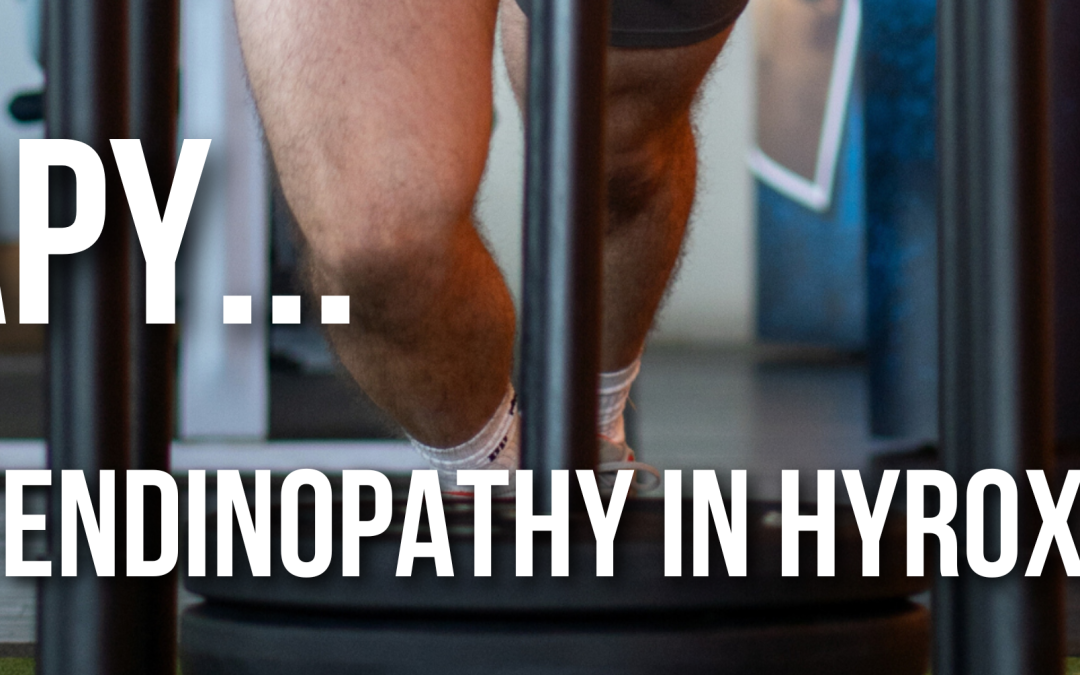Hyrox is a growing fitness challenge that combines strength, endurance and grit. Eight stations of functional exercises are each broken up by 1km runs. While the format pushes you to your limits, it can also take a toll on certain parts of the body. One of the most common areas being the Achilles tendon.
In this blog, we’ll explore Achilles tendinopathy: what it is, why it’s common in Hyrox athletes, how TFD Therapy can help, and what you can do to manage symptoms and stay in the race.

What is Achilles Tendinopathy?
Achilles tendinopathy is a condition that affects the tendon at the back of your ankle, the thick cord that connects your calf muscles to your heel bone. When the tendon is repeatedly loaded, such as through running/jumping during a Hyrox, it can become painful, swollen, or stiff, especially during or after physical activity.
You might notice:
- A dull ache around your heel or lower calf
- Stiffness in the morning or after resting
- Pain when running, jumping, or going up on your toes
Pain in the tendon usually builds up overtime. But can be made worse by a previous acute traumatic event e.g., Achilles tear

Why It Occurs In HYROX?
The unique format of Hyrox, repeated 1km runs mixed with functional stations, can be tough on the Achilles.
Here’s why:
- Repetitive Running: The repeated bouts of running place continuous load on the Achilles, especially if your form breaks down as fatigue sets in.
- Heavy, Explosive Movements: Exercises like sled pushes and burpee broad jumps accumulate stress on the calf muscles, which pull on the Achilles tendon. (Specifically, sled pushing puts the soleus muscle under extra load because of the positive shin angle utilised (i.e., knee over toe). The soleus is a strong muscle and is connected to the Achilles tendon. However, combining sled pushing with repeated running may push the muscle and tendon over the limit.)
- Surface & Footwear: Competing on hard surfaces or using footwear that doesn’t support your running gait can increase the strain.
- Training Volume: A sudden increase in running or high-impact exercises without enough rest or recovery is a major risk factor.

The Different Treatments Available at TFD Therapy
At TFD Therapy, we understand that every athlete’s body and training load is different. That’s why we take a personalised approach to treatment.
Here’s what we can offer:
Soft Tissue Therapy & Sports Massage Our hands-on treatment focuses on reducing tightness in the calf and surrounding muscles, improving circulation, and easing strain on the Achilles tendon. This helps reduce pain, improve movement, and support long-term recovery. Therapies include:
- Sports Massage: A focused deep-tissue massage that targets tight or overworked calf muscles to relieve tension, promote healing, and enhance flexibility.
- Shockwave Therapy: A non-invasive treatment that uses acoustic waves to stimulate blood flow into the Achilles tendon and accelerate the tendon’s natural healing process through acoustic waves.
- Dry Needling: Involves inserting fine needles into the Achilles and calf muscles to release tension, reduce pain, and restore normal function.
- Stretch Therapy: Assisted stretching techniques that help improve muscle length and mobility, reduce tightness around the calf and ankle, and support better overall movement patterns.
- Exercise Rehab: We’ll guide you through a rehab exercises focused on gradually loading the tendon, building strength and restoring resilience.
- Taping & Load Management: Kinesiology taping can help offload the Achilles and reduce discomfort during daily activities or training. These strategies can be especially helpful during flare-ups, allowing you to stay active while managing symptoms, as-well as just before race if you want that extra support and confidence during competition.
- Education & Self-Management: We make sure you understand your injury, what causes flare-ups, and how to manage your training load going forward. Our goal is to give you the tools and confidence to stay in control of your rehab, even outside the clinic.
- Movement Screening & Running Gait Analysis: We can assess how your posture and movement patterns may be contributing to your symptoms and make adjustments to improve movement efficiency and reduce strain.
General Advice on Managing Achilles Tendinopathy
Here are a few ways you can manage Achilles pain, both during training and competition:
- Reduce Load (But Don’t Stop Moving): Avoid high-impact exercises or runs that trigger pain, but don’t completely rest unless advised—movement helps with healing. Understand what sparks more pain and work out a way around it.
- Eccentric and Isometric Exercises: Exercises like heel drops off a step have been shown to support tendon recovery over time. Isometrics are a great way of priming the tendons and muscles of the calf. Tendons like load!
- Train Smart: Gradually build up your running volume and intensity. Avoid big spikes in training. Moniter when running technique breaks down in training.
- Footwear Matters: Use supportive shoes that match your running style and consider changing them if they’re worn down.
- Warm Up: Properly Include dynamic warm up exercises and isometrics for the calf before training and cool down properly afterwards with static stretches and foam rolling.
- Don’t ignore it: Achilles tendinopathy is frustrating but can be managed. Ignoring it will only worsen it over time and increase risk of traumatic strain to the tendon. Not what you want on race day!
Final Thoughts
Achilles tendinopathy is not the end of your Hyrox journey. With the right treatment most people recover and come back stronger. If you’re dealing with persistent Achilles pain, don’t ignore it, early treatment makes a big difference.
At TFD Therapy, we’re here to keep your moving. Whether you’re preparing for your first race or you’re a seasoned competitor, we can help you stay pain-free and race-ready.
Book your appointment today and get back to doing what you love, without pain.

